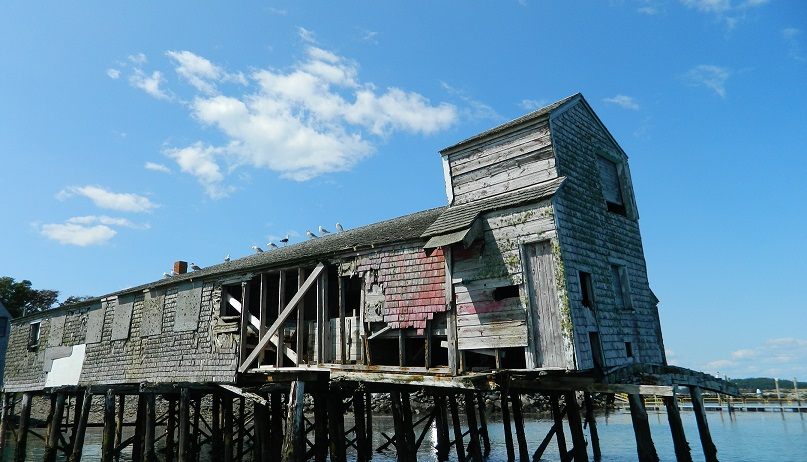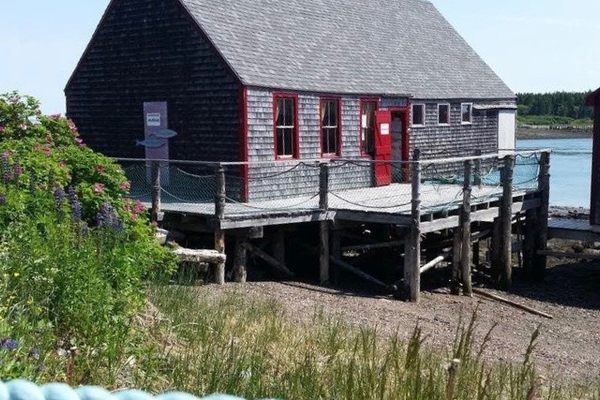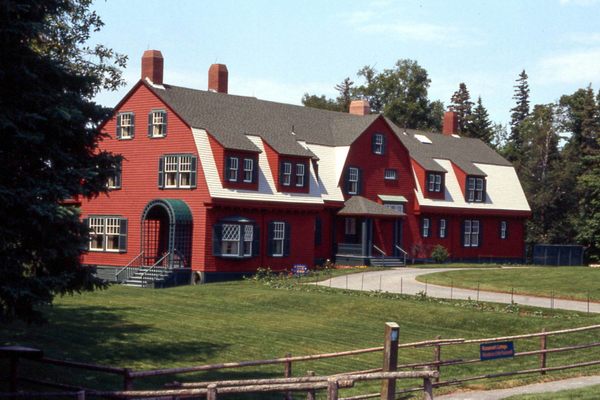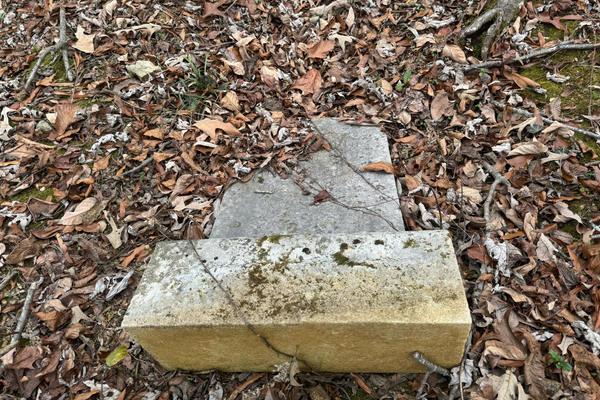The Curious Case of the American Landmark That Floated to Canada
An unlikely international incident surrounding a wayward brining shed.

Rachel Rubeor was kindling a fire when the phone rang. It was a bitter January day in Lubec, Maine, the easternmost town of mainland America, and she wanted a break.
The previous few days had been stressful. A storm had swept through, lashing the community with flurries and wind. Before it arrived, Rubeor, president of the preservation organization Lubec Landmarks, had been concerned about the old brining shed slouching just above the water. The two-story structure is part of the McCurdy Smokehouse complex, once the heart of the town’s herring-smoking operations. Over its many decades, the facility had prepared and packaged tinned fish sent all over the United States and Canada. It closed in 1991 and was added to the National Register of Historic Places in 1993. Though some parts of the operation have been restored as a museum, the brining shed had gone gray, gap-toothed, and weatherbeaten, slumped on rickety pilings pocked with wormholes.
From photos snapped last summer, “you can’t believe it was even standing,” says Sarah Hansen, the real estate manager of Maine Preservation, which included the shed on last year’s list of the state’s most at-risk historic sites. “It’s a trooper, man.”
Rubeor had been worried about how the shed would fare in the storm. Even under normal conditions, the nearby waters see some of the highest tides in the world, which is why many buildings are perched atop makeshift stilts. In early January, the high tide in Lubec could rise more than 20 feet. Her fears were realized, as the storm and tide conspired to wrest the fragile building off its supports and into the water.
It wasn’t so bad, Rubeor reasoned. Even though it was on the loose, the building didn’t get far. It seemed to be wedged in place just down the shore. Once the weather improved, she figured, a contractor could retrieve it and coax it back into place.
Then the phone rang. “A friend of mine called,” Rubeor remembers, “and said, ‘Rachel, the brining shed just floated by my house.’”
Rubeor raced to the site of a former cat food factory, where a cluster of locals were watching the giant shed drift away. It wandered in and out of the vapor plumes like a ghost. Heather Henry Tenan, who owns a local motel, grabbed her iPad and ran to the water, where she captured video of the shed easing under a bridge. There’s no sound in the video, but that’s probably for the best, she says—“there were fishermen swearing profusely.”
Nudged along by the current, the shed floated across the Lubec Narrows and beached itself on Campobello Island. It wasn’t a long trip—at its tightest, the distance from one shore to the other is roughly 1,300 feet. “You stand downtown in Lubec and you look at Campobello,” Hansen says. “It’s right there.” But somewhere in the middle of the channel, the landmark crossed a line. It had migrated, quite by accident, from the United States to Canada.

It was no secret that the brining shed was in rough shape long before the storm swept it away. Despite its condition, it was one of the few structures of its kind still standing, Hansen says. The others, scattered across the region, had tumbled down or been dismantled. Even so, the local landmarks organization had trouble rustling up the money to halt its decline. The Maine Preservation report from 2017 called for $125,000 in stop-gap measures. “We couldn’t raise the money fast enough,” Rubeor says.
Not everyone thought it was worth the money or time. “There were people in town who just said, ‘Let it go,’” Rubeor says. It is tiring work to keep a building that wants to fall from falling, and some locals still remember, without fondness, long days working there, crusted with the scent of brine and lanced fish.
By January, things weren’t looking good for the shed. Rubeor thought about borrowing a boat to remove some of the artifacts that were still inside, such as the pickling vats, but couldn’t find one big enough. “It was a perfect storm,” she says.

Under maritime law, items bobbing in the water are typically considered fair game. “If you look at it from just a salvage perspective, it’s like a bunch of stuff washed up on the beach—of course it doesn’t belong to anybody,” Hansen says. “This is such a rare thing, where a building literally came off its pilings and floated just across the way.” Add in the landmark designation and the national border it crossed, and “no one really knows exactly what to do or what the protocols are.”
The case “is entirely an event in its own right, as far as I know of,” says Brian Turner, a senior field officer and public lands attorney for the National Trust for Historic Preservation. Typically landmarks are deeply rooted in place—they stay put unless deliberately moved. But the ocean bearing cultural material between countries—without the help of a ship—isn’t unheard of. Months after the 2011 tsunami that devastated parts of Japan, debris began washing ashore on the Pacific coast of North America. Many of these objects were indistinguishable from common marine litter, but the handful that could be traced back to the tsunami, including a soccer ball and a motorcycle, were eventually repatriated.
These examples are unusual, but they’re extreme scenarios that are likely to become more common as seas rise and storms pick up intensity. Already, Hansen says, officials in Maine are noting that erosion is profoundly changing shorelines. Tides are lapping higher. Rivers are spilling over more often. Meanwhile, there aren’t yet hard-and-fast best practices for shoring up or moving old structures near the water—let alone perched over it.

Once the shed crashed into Canada, “I spent the day frantically calling Coast Guard, RCMP, DEP, all the people involved, telling them that this was over in Campobello, and we wanted desperately to bring it back,” Rubeor says. She’d heard that Canadians had flocked to see what they could wrestle from the wreckage. Someone had scaled the roof and hung a Canadian flag from the brick chimney. (After all, many of the bricks were Canadian-made.) The maple leaf was joined by a Jolly Roger. “I own the fact that I am a scavenger,” a woman who lives on Campobello Island told the Bangor Daily News, as she took a chainsaw to the building. “My basement is full of it.”
Things escalated. Rubeor was scolded for referring to the Canadian scavengers as “vandals” out to “cannibalize” the shed. “As Mayor of Campobello Island, I was deeply offended by the thoughtlessness of the comments and characterization of my community,” says Stephen Smart, who is also the operations manager of Roosevelt Campobello International Park. Some on Campobello Island argued that the Mainers had given the shed over to utter and irreparable disrepair, and said it should be treated like driftwood—free for the taking. “I would say the shed headed to Campobello for the healthcare that it was not receiving in Lubec,” Smart says.
In response, the satirical New Maine News reported that Canadian Prime Minister Justin Trudeau offered each Lubec resident a voucher for a free hug, “to help soothe the tensions between our nations.”

The exchange was unusually fiery for people with personal connections across the border. Some of Campobello’s 872 residents are dual citizens, and cross over to Maine to visit the nearest medical center. Others live in Lubec and commute to Canada for work, notes Vern McKimmey, marketing and guest services manager for Roosevelt Campobello International Park. (Franklin Delano Roosevelt often summered on the island, and his 34-room cottage is on parkland jointly managed by both nations.) The tourism bureaus trumpet international goodwill: “A gateway to your two-nation vacation,” Campobello’s tourism website reads. “Don’t forget to bring your passport!” The U.S. National Park Service site similarly describes the park as a “symbol of cooperation between the U.S. and Canada.” Perhaps there simply hadn’t been a flashpoint for discord before.
But this controversy, like the shed, seemed to blow over, almost as quickly as the storm that caused it. “At the end of the day, our two communities will continue to cooperate, socialize, and live side by side, as we have for over 200 years,” Smart says. Neighborliness and civility were restored, and the two countries worked together to haul the structure back to Maine, where they agreed it belongs.
Along its international journey, the shed accumulated new wounds, and it was deemed too weak to float back. Instead, a team of contractors—from both sides of the border—disassembled it on the Canadian shore. Rubeor estimates that seven or eight truckloads of historic debris have crossed the bridge back to Lubec.
Now a contractor must determine what is salvageable. With these original materials, Lubec Landmarks plans to build a replica of the brining shed with a smaller footprint. The McCurdy Museum has a lot of historical materials, including photographs, to work from. The documentation that had been required to petition for listing on the National Register of Historic Places will come in handy, too, explains Turner. “You have a record to start with, if you did want to engage in a reconstruction activity.” With enough fidelity to the original, it should be able to retain its historic designation.
It’s possible that the international incident could end up being a blessing in waterlogged disguise for the historic herring complex. Rubeor says they’re now swinging for big grants, which will allow them to “take on saving the remainder of the buildings and go whole hog.”
“We’ll be as historically accurate as we can,” Rubeor says. They plan to reinstall the pickling vats and put up interpretative signs for visitors. It will be a heavy lift for the contractor, but it’s “not as if he’s rebuilding a Gothic revival building,” Rubeor says. “This was a brining shed, and it was a wood structure. Nothing fancy.”
























Follow us on Twitter to get the latest on the world's hidden wonders.
Like us on Facebook to get the latest on the world's hidden wonders.
Follow us on Twitter Like us on Facebook